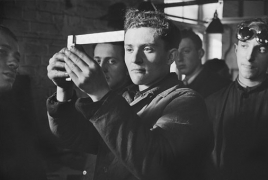Contemporary Jewish Museum marks influential career of Roman Vishniac February 12, 2016 - 11:34 AMT PanARMENIAN.Net - More than any other photographer, Roman Vishniac profoundly influenced contemporary impressions of Jewish life in Eastern Europe. Vishniac created the most widely recognized and reproduced photographic record of that world on the eve of its annihilation, yet very little of his work was published or printed during his lifetime (1897–1990). Known primarily for this poignant record, Vishniac was in fact a remarkably versatile and innovative photographer. His body of work spans more than five decades, ranging from his early engagements with European modernism in the 1920s, to his portrait photographs in New York City from the 1940s, and his highly inventive color photomicroscopy in the 1950s–70s. Now, The Contemporary Jewish Museum presents Roman Vishniac Rediscovered, an exhibition that reveals the full range of Vishniac’s radically diverse body of work—much of it only recently discovered, Art Daily said. Drawn from the extensive Roman Vishniac Archive at the International Center of Photography (ICP), New York City, Roman Vishniac Rediscovered presents newly discovered vintage prints, film footage, personal correspondence, and exhibition prints made from recently digitized negatives for a comprehensive reappraisal of the photographer’s output. Nearly 400 objects, including photographs, negatives, books, journals, and ephemera—many of them never seen before this exhibition premiered at the ICP in 2013—reveal a compositional acuity, inventiveness, and surprising stylistic range that solidifies Vishniac’s place among the twentieth century’s most accomplished photographers, and repositions his iconic photographs of eastern European Jewry within a broader tradition of social documentary photography. “Vishniac’s 1983 monograph A Vanished World is on the bookshelf of every Jewish family I know, including my own,’ says Lori Starr, Executive Director of The CJM. “His powerful photographs are iconic images of our shared history. With this exhibition, we now have the opportunity to see these widely familiar works in the context of Vishniac’s entire oeuvre and to understand him as a major modernist photographer and profoundly important artist.” “Roman Vishniac Rediscovered presents, for the first time, five decades of work by a legendary photographer who was previously known for photographs spanning only four years,” says Maya Benton, exhibition curator, from the ICP. “The vast holdings of the Roman Vishniac Archive, which includes 10,000 negatives and more than 50,000 objects, have allowed us to reposition Vishniac as one of the great photographers of the twentieth century.” Over the course of his lengthy career, Vishniac witnessed the sweeping artistic innovation of the Weimar era in Berlin, the Nazi Party’s ominous rise to power in Germany, the final years of traditional Jewish life in Eastern Europe, and immigrant life in America during and after World War II. Born in Russia in 1897 to an affluent Jewish family, Vishniac grew up in Moscow. After pursuing graduate degrees in biology and zoology, he immigrated to Berlin in 1920 in the aftermath of the Bolshevik Revolution. As an amateur photographer he took to the streets, offering witty visual commentary on day-to-day life in his adopted city. This prodigious body of early work reflects the influence of European modernism and an avant-garde approach to framing and composition. Vishniac’s development as a professional photographer coincided with the Nazi rise to power, and he tenaciously documented the ominous changes he encountered—images of campaign posters, swastika banners, and marching soldiers dominate work from this era. As restrictions on Jewish photographers increased, he was commissioned to document the work of several Jewish community and social-service organizations in Berlin. In 1935, he was hired by the American Jewish Joint Distribution Committee (JDC)—the world’s largest Jewish relief organization—to photograph impoverished Jewish communities in Central and Eastern Europe as part of the organization’s effort to raise funds and support. Vishniac’s four years of work on the project yielded the celebrated images that have largely defined his photographic legacy. Following a brief period of internment in France, Vishniac arrived in New York in 1941 and opened a portrait studio to support his family. Throughout the 1940s, Vishniac continued to chronicle the impact of World War II while working to establish himself in the fields of science and photomicroscopy, or photography through the microscope. He photographed the war-relief efforts of Chinese Americans in New York; he documented the arrival of Jewish refugees and Holocaust survivors; and he followed American Jewish life throughout the 1940s and 50s. In 1947, he returned to Europe to document relief efforts in Jewish Displaced Persons camps and the ruins of his former hometown, Berlin. Photomicroscopy became Vishniac’s primary focus for the last 45 years of his life. By the mid-1950s, Vishniac had established himself as a pioneer in the field, developing sophisticated techniques for photographing and filming microscopic life forms. His scientific photography appeared in hundreds of magazine and journal articles and on dozens of covers. One of Vishniac’s most famous endeavors in the field was his revolutionary photographs from the inside of a firefly’s eye. Photo: Mara Vishniac Kohn, courtesy International Center of Photography The creative crew of the Public TV had chosen 13-year-old Malena as a participant of this year's contest. She called on others to also suspend their accounts over the companies’ failure to tackle hate speech. Penderecki was known for his film scores, including for William Friedkin’s “The Exorcist”, Stanley Kubrick’s “The Shining”. The festival made the news public on March 19, saying that “several options are considered in order to preserve its running” Partner news |